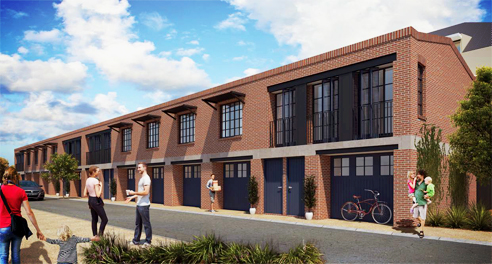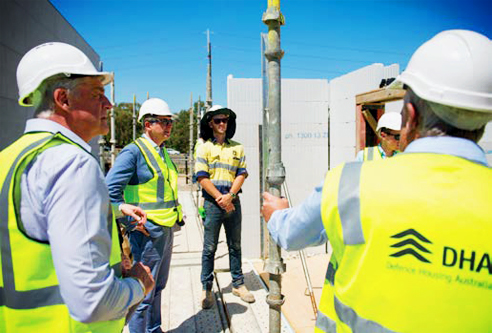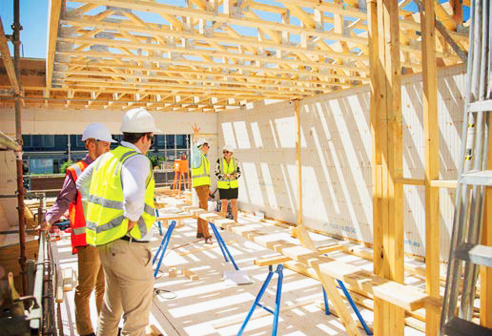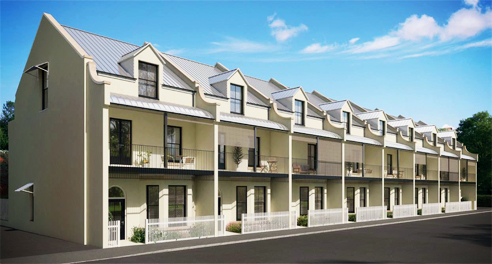The Princes Terrace Adelaide brings low-carbon lessons learnt in the UK to Australia - and shows why innovative thinking and clever design can create spectacular, sustainable outcomes that stand the test of time.
"The Princes Terrace Adelaide demonstrates that small projects can make big impact when it comes to sustainability," says Romilly Madew, Chief Executive Officer of the Green Building Council of Australia.
"As the first residential project in Australia to achieve a 6-Star Green Star rating, each home within the Princes Terrace Adelaide will use 50 per cent less energy and 50 per cent less potable water than a typical urban dwelling."
The result of a unique collaboration between HRH Prince Charles' Princes Foundation for Building Community, Princes Charities Australia, Renewal SA and Defence Housing Australia, the Princes Terrace Adelaide demonstrates how accessible low-carbon living can be achieved without compromising quality, affordability or finish.
David Toman, Chief Executive of The Princes Foundation for Building Community, says the project 'brings alive' many of the Foundation's key principles: "The project applies many of the lessons we've learnt from our work in the UK, while evoking the specific heritage of the site, and using local materials to create a harmonious and enduring community."
The Princes Terrace Adelaide not only reflects the much-loved terrace homes that have featured throughout Australian history, but also builds on that heritage by creating a series of terraced homes that are environmentally friendly and sustainable.
The philosophy behind the design was to blend rich, local heritage with contemporary living.
"We wanted to build for today with a strong focus on sustainability and the environment, while recalling traditional Australian terrace architecture. This exterior is not only decorative, but it is functional in creating a more sustainable home," David explains.

Redefining sustainable living
Located in the burgeoning community of Bowden, the Princes Terrace Adelaide features eight three-bedroom townhouses, and four coach mews units - a reflection of the areas architectural legacy.
A former industrial site, Bowden is undergoing a radical transformation that is redefining sustainable living in South Australia.
The development has gained national recognition for Renewal SA's bold action to mandate all new buildings within the community to achieve a minimum 5-Star Green Star rating. Renewal SA has also achieved a 6-Star Green Star - Communities rating for the entire precinct.
"Defence Housing Australia is passionate about building sustainable, thriving communities, and this starts with housing," says Jan Mason, DHA's Managing Director.
"For our Defence families, this means passing on not just financial savings that come with more sustainable design, but a healthy and active lifestyle that will provide a better future for their children."

Built for performance
The Princes Terrace Adelaide project has been designed to be extremely climate responsive and ensure comfort for residents.
Starting with sustainable design basics, each dwelling has been orientated to maximise natural daylight and to passively heat and cool throughout the year. Shading devices and balconies have also been optimised to allow the sun in the winter and shade in the summer. All dwellings have also been designed to promote natural cross ventilation for cooling in the summer, as well as ensuring healthy airflow.
The building fabric - walls and roofs - will be well insulated to ensure comfortable internal temperatures as well as efficiency of air conditioning systems. Double-glazed windows are also specified throughout for energy efficiency and acoustic comfort. The project will use mainly low energy heating and cooling systems, like ceiling fans in summer and fireplaces in winter. While the need for air conditioning has been reduced, highly efficient zoned systems can be switched on during peak Adelaide temperatures.
Each dwelling will also have a 1.5kW photovoltaic array installed on the roof, helping to reduce energy use during the day.
The result? A building that uses 50 per cent less energy and produces fewer greenhouse gas emissions than a standard Australian residential dwelling.
"From early stages in the project design, the team utilised computer simulation and holistic design analysis to inform the building form and sustainable performance. Spending time on this analysis early in the design allowed us to test many scenarios, to ensure the future home owners benefit from the most appropriate construction," says Deborah Davidson of dsquared Consulting, the project's sustainability consultant.

Local and low carbon materials
Local, low-carbon building materials are a hallmark of the Princes Terrace Adelaide, such as locally made concrete with blast furnace slag content (as waste product), local granite and bricks re-used from old Bowden industrial buildings. All timber used in the project will also be from certified sustainable sources.
Procuring high-quality, durable and sustainable materials locally has necessitated extra flexibility during the design process.
"The design initially called for black granite benches, however Adelaide's local granite is red in colour. We worked closely with the design team to make this change - and as a result, we have a material that is not only attractive and locally-sourced, but generates fewer emissions during transport to the site," says Jan Mason.
"Using natural, locally-sourced materials also supports a more sustainable supply chain - so this project is helping to build skills and opportunities locally."
The project is also undertaking a full lifecycle assessment to measure the total environmental impact including the embodied energy in materials in construction, energy use in operation and impact at end of life.








 FireFORM Fire Rated Walls by ZEGO
FireFORM Fire Rated Walls by ZEGO Foam Panels for Wall Cladding by ZEGO
Foam Panels for Wall Cladding by ZEGO ReForm Reusable Form for Sustainable
ReForm Reusable Form for Sustainable Insulated Concrete Form Training by ZEGO
Insulated Concrete Form Training by ZEGO How to Build a Swimming Pool with Zego
How to Build a Swimming Pool with Zego Insulated Slab Flooring System by ZEGO
Insulated Slab Flooring System by ZEGO FireFORM for Water Tanks by ZEGO
FireFORM for Water Tanks by ZEGO Reusable Formwork for Construction by
Reusable Formwork for Construction by External Insulating Facade System
External Insulating Facade System ZEGO Insulated Concrete Formwork Project
ZEGO Insulated Concrete Formwork Project Sustainability Net Zero Emissions 2050
Sustainability Net Zero Emissions 2050 Fire Rated Walls for High-Rise Buildings
Fire Rated Walls for High-Rise Buildings Fire Rated Walls for High-Rise Buildings
Fire Rated Walls for High-Rise Buildings Fire-rated Insulated Concrete Formwork
Fire-rated Insulated Concrete Formwork Sustainable Building Construction Using
Sustainable Building Construction Using Thermally Efficient Walls, Floors, and
Thermally Efficient Walls, Floors, and Class 4 Reinforced Concrete Walls and
Class 4 Reinforced Concrete Walls and Rebuilding with ICF's Post Bushfire
Rebuilding with ICF's Post Bushfire Insulated Concrete Formwork Advantages
Insulated Concrete Formwork Advantages Recyclable Formwork for Award Winning
Recyclable Formwork for Award Winning
